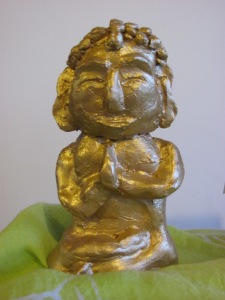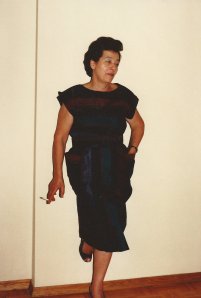
by Dr. Talia Marcheggiani, ND | May 16, 2013 | Balance, Community, Culture, DIY, Family, Finding yourself, Happiness, Health, Letting Go, Mental Health, Mindfulness, Nature, Nature Cure, Philosophy, Relationships, Spirituality, Stress

Taganga, Colombia
What does space mean to you? Is it a necessity? A status symbol? A burden?
A friend and I recently went to see a documentary at the Toronto Hot Docs festival called Tiny: A Story About Living Small. The doc follows a young couple who embark on the project of building their own tiny house, measuring roughly 100 square metres, in order to secure their footing in an increasingly growing movement of downsizing living spaces in favour of simplicity.
(more…)

by Dr. Talia Marcheggiani, ND | Jul 5, 2012 | Addiction, Alcohol, Balance, Culture, Emotions, Exams, Family, Law of attraction, Letting Go, Meditation, Mental Health, Mindfulness, Psychology, Spirituality, Stress, Yoga
 Serenity, in New Age culture, usually depicts the complacent grin of someone who has risen “above it all”. Clad in white robes, with a wooden chain of prayer beads strung around the neck, this serene being does 10-day meditation retreats, feels at home in lotus pose and is most frequently removed from society.
Serenity, in New Age culture, usually depicts the complacent grin of someone who has risen “above it all”. Clad in white robes, with a wooden chain of prayer beads strung around the neck, this serene being does 10-day meditation retreats, feels at home in lotus pose and is most frequently removed from society.
(more…)

by Dr. Talia Marcheggiani, ND | May 31, 2012 | Asian Medicine, Balance, Community, Emotions, Family, Finding yourself, Meditation, Mental Health, Mindfulness, Spirituality, Stress, Urban Living
 I used to play in the laneway behind Clinton and Bloor, in Toronto’s west end. The laneway marked the arteries of my childhood world, directing me to the shops on Bloor, Honest Ed’s and Christie Pits park.
I used to play in the laneway behind Clinton and Bloor, in Toronto’s west end. The laneway marked the arteries of my childhood world, directing me to the shops on Bloor, Honest Ed’s and Christie Pits park.
(more…)
by Dr. Talia Marcheggiani, ND | May 4, 2012 | Balance, Healing Stories, Preventive Medicine, Self-care, Spirituality, Stress
As soon as exams screamed to a halt, I embarked on my summer reading list starting with When the Body Says No, by Canadian author and medical doctor, Gabor Maté. This book explores the mind-body connection, the relationship between stress, especially due to familial relationships, and the onset of disease.
(more…)
by Dr. Talia Marcheggiani, ND | Jan 31, 2012 | Asian Medicine, Ayurvedic Medicine, Family, Homeopathy, Law of attraction, Love, Spirituality
We’ve all heard the Golden Rule before: “Do unto others as you would have them do unto you”, and its many variations. But, how valid is this rule and it’s impact on leading a happy, healthy and morally sound life? I look at lessons in homeopathy and ayurvedic philosophy for insight.
Ayurvedic philosophy states that the reason for abstaining from morally unsound deeds (lying, stealing, killing, etc.) is because, once one begins to engage in these acts, one begins to create a world in which these acts become feasible. In essence, the ayurvedic philosophers claim that we create our own reality: once we begin to steal and lie, we create a reality in which stealing and lying becomes possible and we run the risk of other people beginning to steal and lie to us.
This concept of creating your own reality is inherent in homeopathic theory as well. In homeopathy, in order to understand the case that a patient presents with we must examine every minute detail about the patient. If someone expresses a frustration about something or someone that appears distinct from themself (“people are liars” or “you can’t trust anyone”) they are really expressing a statement about themselves. Our professor Dr. Nadia Bakir tells us that in order to recognize something about our environment we are really recognizing it from a point deep within ourself. If we didn’t already embody this characteristic then we wouldn’t be able to observe it in others – it wouldn’t be a part of our reality. In some ways it makes sense, those who embody the characteristic of cynicism tend to see the negative side of life, ignoring the positive and even managing to manifest negative outcomes in their own life situations.
This means that, in order to live in a world where people are honest, thoughtful and generally concerned about others we must first work to cultivate those characteristics in ourselves. As Gandhi says “Be the change you wish to see in the world”.
It must be said that these concepts can be dangerous if we take them a step further and claim that people who are the victims of unfortunate accidents or deadly diseases “brought it on themselves”. However, there is some evidence that suggests people who think positively about their cancer diagnoses, for example, experience greater quality of life and a better prognosis.
This philosophy is not meant to undermine those who have experienced loss or are going through a difficult time. It only serves as an inspiration for those who wish to cultivate a better world and take some responsibility for their outlook on life. It’s important to understand that we don’t each live in our glass bubble. Our personal views manifest as actions and our actions affect other people, which in turn affect how those people react to us. So, in a sense there is some truth to “doing unto others as you would have them do unto you.”
by Dr. Talia Marcheggiani, ND | Jan 14, 2012 | Art, Exercise, Love, Meditation, Mental Health, Mindfulness, Psychology, Spirituality, Stress
Last semester I took the Ayurvedic Lifestyle course at CCNM, taught by Matthew Remski. In this course, one of the ideas that most resonated with me was the concept of “I Am” Moments. These are moments where the past and future fall away and we become ingrained in the present moment. Some of you might refer to them as moments of pure passion or exhilaration.
The best examples of I Am Moments are seen in animals. When I take my dog to High Park, the moment I reach down to unclasp his leash and set him free, he enters his state of “I Am.” Ears flying back, fur plastered against his face as he tears through the inner city forest, he loses all sense of past, present and future and becomes the being he was born to be. You can almost hear him exclaiming “I am I am I Am a DOG!”
He’s not self-conscious about the fact that his legs are flopping awkwardly behind him, that his body is too long or too low to the ground or that his fur is too shaggy. As he pauses for a second to turn to me with his mouth open in what can only be described as a “doggy smile”, I can almost hear him say, “thank you thank you thank you for not stuffing me into a purse and taking me to the mall. Thank you for letting me race, chase and roll in poop! Thank you for letting me be the way that nature designed me, thank you for letting me be a DOG!”
So, there you have it, an example of an “I Am” Moment.
I can perfectly identify my own I Am Moments, which I’ve experienced since childhood. I’m in a large, open space, full of art materials, where I am free to make a mess, get dirty and move freely, I have paints, canvasses, paper, pictures and glue. Whether I decide to paint a landscape or construct a giant papier maché bird mask, I am free to sculpt, to paint and to CREATE.
When I enter this state, time no longer seems to matter and I just melt into the moment. I feel that I am doing something perfectly natural for me and, in honouring nature, it is as if I enter into a state of Wholeness; I become a part of everything and everything becomes a part of me.
Your own I Am Moments may be stimulated by different things. You may have them when you run, dance, horseback ride or mountain climb. Perhaps you enter your I Am Moment when you take a patient history, solve a mathematical equation, buy and sell stocks, prepare a nutritious meal, teach a class, drive your car or relax with an inspiring book and a cup of steaming tea.
During these moments you lose a sense of the details of your life and of your problems, which no longer seem important or relevant. You cease to care about how your butt looks in your jeans, if you’re wearing the right shoes, if your hair is too frizzy or the fight you had with your mother. Your mind is absolutely clear of thoughts and you feel a sense of connection with the (excuse me) Divine. You feel as if you’re flowing with everything, as if you are part of the whole.
The point of this post is to get you to think about and honour these I Am Moments in your life. If you can’t put your finger on a specific time that you had a sense of I Am, I encourage you to think back to your childhood. Children continually operate out of “I Am” because they are naturally unself-conscious. That is, until they become corrupted with our adult insecurities and “lessons” about the importance of what others think. As a kid you operated from an uninhibited place, where you were stimulated by an awe of life and lived in the novelty of the present.
When you discover what triggers these moments in your life, make an effort to create time for them and use them as inspiration for the rest of your life. I Am Moments are the key to getting us back to our natural state; a state that is free of disease, in which the energy of our own vitality can flow freely.






